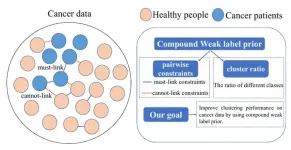(Press-News.org)
Researchers from the University of Tokyo performed the first study to quantify highly processed food consumption and to investigate its association with diet quality among Japanese children and adolescents. Highly processed foods (HPFs) accounted for over one-fourth of the total energy intake amongst youths. Consumption was negatively associated with the intake of healthy foods, such as fruits, vegetables and pulses, and positively associated with the consumption of confectioneries.
It's common knowledge that poor-quality diets are considered major risk factors for many health issues and even noncommunicable diseases such as Type 2 diabetes. Therefore, researchers seek to understand factors related to diet quality as a way to improve people’s health. Research on HPFs has been rapidly increasing, highlighting their potential impact on public health. However, few studies have been conducted in Japan, with none focusing on children and adolescents, due to challenges in assessing them.
“Our previous research on HPF consumption in adults in Japan found that higher consumption was negatively associated with diet quality. This significant finding prompted us to investigate whether similar associations exist in younger generations,” said Assistant Professor Nana Shinozaki from the School of Public Health. “My team and I ran a cross-sectional study, one where many people are assessed in a short space of time rather than fewer people over a long period of time, to understand the association between HPF consumption and overall diet quality among Japanese children and adolescents. We found that higher HPF consumption is associated with poorer diet quality in 1,318 participants aged 3-17 years.”
This probably doesn’t come as a surprise to many, but it’s important to note that this is the first time hard data has been put to this specific demographic, and that fact might aid in improving public health. One of the difficulties in research on diets is that so many of the issues lack precise definitions. For this reason, Shinozaki and her team picked an existing dietary classification framework developed by researchers at the University of North Carolina at Chapel Hill (UNCCH) in the U.S. to classify the food that participants consumed, and the Healthy Eating Index-2020 and the Nutrient-Rich Food Index 9.3 to evaluate the quality of their diets. Under the UNCCH classification, HPFs are defined as “multi-ingredient, industrially formulated mixtures processed to the extent that they are no longer recognizable as their original plant/animal source.”
“The biggest challenge was collecting detailed dietary data, which are essential to identify which foods are HPFs, on eight days over the course of a year from a large sample of about 1,300 individuals,” said Shinozaki. “This process of assessment by researchers, and assessments by participants or parents, was highly burdensome for both participants and investigators due to the need for accurate and consistent recording of dietary intake. Our research could not have been accomplished without the support of research dietitians throughout Japan, who played a crucial role in supporting participants and collecting data.”
What might surprise some readers is that the cliché of Japan’s national diet being the model of healthy eating is a little inaccurate and out of date.
“Professor Kentaro Murakami (of the University of Tokyo) recently found that in a nationally representative sample of Japanese adults, the mean total score of the Healthy Eating Index-2015, a widely accepted diet quality index, was similar to that of average Americans. This finding suggests that the Japanese diet would not be as healthy as expected,” said Shinozaki. “Wherever you may be, at the individual level, increasing the consumption of unprocessed or minimally processed foods, especially fresh fruits and vegetables, would be helpful. At the societal level, public awareness campaigns, policy and regulation, or food availability and market changes to promote the reduction of HPFs could be beneficial. Our findings support ongoing efforts to develop nutritional guidelines and public health strategies aimed at reducing the prevalence of diet-related diseases.”
###
Journal article:
Nana Shinozaki, Kentaro Murakami and Kimoto N. “Highly processed food consumption and its association with overall diet quality in a nationwide sample of 1,318 Japanese children and adolescents: A cross-sectional analysis based on 8-day weighed dietary records”, Journal of the Academy of Nutrition and Dietetics, DOI: 10.1016/j.jand.2024.06.001,
Link: https://www.sciencedirect.com/science/article/pii/S2212267224002673?via%3Dihub
Funding: This research was funded by the Ministry of Health, Labor and Welfare, Japan (grant number 20KA1009). The Ministry of Health, Labor and Welfare had no role in the design, analysis, or writing of this article.
Useful links:
Department of Social and Preventive Epidemiology
http://www.nutrepi.m.u-tokyo.ac.jp/english/index.html
School of Public Health
https://www.m.u-tokyo.ac.jp/sph/en/en-highlight/
Graduate School of Medicine
https://www.m.u-tokyo.ac.jp/english/
Research contact:
Assistant Professor Nana Shinozaki
Graduate School of Medicine, The University of Tokyo,
7-3-1 Hongo, Bunkyo-ku, Tokyo, 113-8656, Japan
nana-s@m.u-tokyo.ac.jp
Press contact:
Mr. Rohan Mehra
Public Relations Group, The University of Tokyo,
7-3-1 Hongo, Bunkyo-ku, Tokyo, 113-8656, Japan
press-releases.adm@gs.mail.u-tokyo.ac.jp
About The University of Tokyo:
The University of Tokyo is Japan's leading university and one of the world's top research universities. The vast research output of some 6,000 researchers is published in the world's top journals across the arts and sciences. Our vibrant student body of around 15,000 undergraduate and 15,000 graduate students includes over 4,000 international students. Find out more at www.u-tokyo.ac.jp/en/ or follow us on X (formerly Twitter) at @UTokyo_News_en.
END
An international research team has discovered a new way to effectively treat cancer, by using nutrients to reactivate suppressed metabolic pathways in cancer cells.
The researchers used a common amino acid, tyrosine, packaged as a nanomedicine, to change the metabolism of melanoma, a deadly skin cancer, and prevent cancer growth.
Australia has the highest rate of skin cancer in the world. This new approach could be combined with current therapies to better treat melanoma. The technique also has the potential to treat other types of cancer.
The study, Nutrient-delivery and metabolism reactivation therapy for melanoma, was led by Professor Wenbo ...
Clustering is widely exploited in data mining. It has been proved that embedding weak label prior into clustering is effective to promote its performance. Previous researches mainly focus on only one type of prior. However, in many real scenarios, two kinds of weak label prior information, e.g., pairwise constraints and cluster ratio, are easily obtained or already available. How to incorporate them to improve clustering performance is important but rarely studied.
To deal with this problem, a research team led by Chenping ...
Chronic wounds, which include diabetic ulcers, surgical wounds, pressure injuries, and other problems, are deadlier than many people realize. Patients with chronic wounds have a five-year survival rate around 70%, worse than that of breast cancer, prostate cancer and other serious diseases. Treating wounds is also expensive, costing an estimated $28 billion each year in the U.S. alone.
A team of researchers from the Keck School of Medicine of USC and the California Institute of Technology (Caltech) is developing a series of cutting-edge technologies to revolutionize wound care, including smart bandages that would automatically sense and ...
A test that looks for genetic hallmarks of brain cancers in samples of cerebrospinal fluid can decrease the time to diagnosis and eliminate the need for invasive brain biopsies for some patients. Mass General Brigham experts in neurosurgery, cancer and pathology worked together to develop a rapid, genotyping test that can detect key mutations associated with brain cancers from samples taken during a lumbar puncture. The team evaluated the technique known as TetRS (Targeted Rapid Sequencing) among 70 patients admitted to Massachusetts General Hospital with new central nervous system ...
It’s one of the fastest growing industries globally, raking in millions for the best players and attracting a huge fanbase, but a new Australian study has revealed the dark side of professional video gaming: cyberbullying and sexual harassment.
Even though the esports industry is a diverse community, cyberbullying is rampant in this virtual world, and cis-gendered and trans-gendered women players are disproportionately more likely to be sexually harassed than men.
Despite women making up 46% of the world’s three billion video gamer players, according to a new paper published in Entertainment Computing, women who play professionally (16% of esports competitors ...
Scientists at the Schmid College of Science and Technology at Chapman University developed a novel way to observe the elusive burrowing behavior of hagfish. Dr. Douglas S Fudge and his team created a specialized tank of transparent gelatin in order to visualize how the hagfish behave and locomote within sediments.
Hagfishes are bottom-dwelling marine animals that are capable of producing startling amounts of defensive slime when they are provoked. Understanding the burrowing activities of hagfishes could lead to increased knowledge of sediment turnover in marine benthic habitats, new insights into the reproductive behavior of hagfishes or ...
Eye-contact has a significant impact on interpersonal evaluation, and online job interviews are no exception. In addition to the quality of a resume, the direction of the interviewee’s gaze might help (or hinder) their chances of securing the job.
Researchers published their results in Scientific Reports on May 31.
The study simulated online job interviews. Twelve students who participated in the study as a role of interviewees presented themselves twice, once looking directly at a web camera, and the other looking towards the screen. ...
An NYU Tandon School of Engineering project led by Chinmay Hegde – Associate Professor in the Department of Computer Science and Engineering and the Department of Electrical and Computer Engineering – is one of the first 35 initiatives selected for the National Artificial Intelligence Research Resource (NAIRR) Pilot by the U.S. National Science Foundation (NSF) and Department of Energy, a result of President Biden's Executive Order on the Safe, Secure and Trustworthy Development and Use of AI.
The NAIRR Pilot aims to connect U.S. researchers and educators with the computational power, data resources, ...
A team of scientists used NASA’s James Webb Space Telescope to parse the composition of the Crab Nebula, a supernova remnant located 6,500 light-years away in the constellation Taurus. With the telescope’s MIRI (Mid-Infrared Instrument) and NIRCam (Near-Infrared Camera), the team gathered data that is helping to clarify the Crab Nebula’s history.
The Crab Nebula is the result of a core-collapse supernova from the death of a massive star. The supernova explosion itself was seen on Earth in 1054 CE and was bright enough to view during the daytime. The much fainter remnant observed today ...
https://www.scienceopen.com/hosted-document?doi=10.15212/AMM-2023-0049
Announcing a new publication for Acta Materia Medica journal. Portal vein tumor thrombosis (PVTT), a severe complication of hepatocellular carcinoma (HCC), markedly influences patient prognosis by fostering a hypercoagulable state. However, its molecular underpinnings remain largely unexplored. This study sheds light on the critical role of the KIT ligand (KITLG) in modulating expression of the collagen gene COL4A1 via the STAT3-SMAD2 signaling pathway, thereby influencing platelet activation and PVTT development. Extensive analysis of PVTT tissue samples, ...




